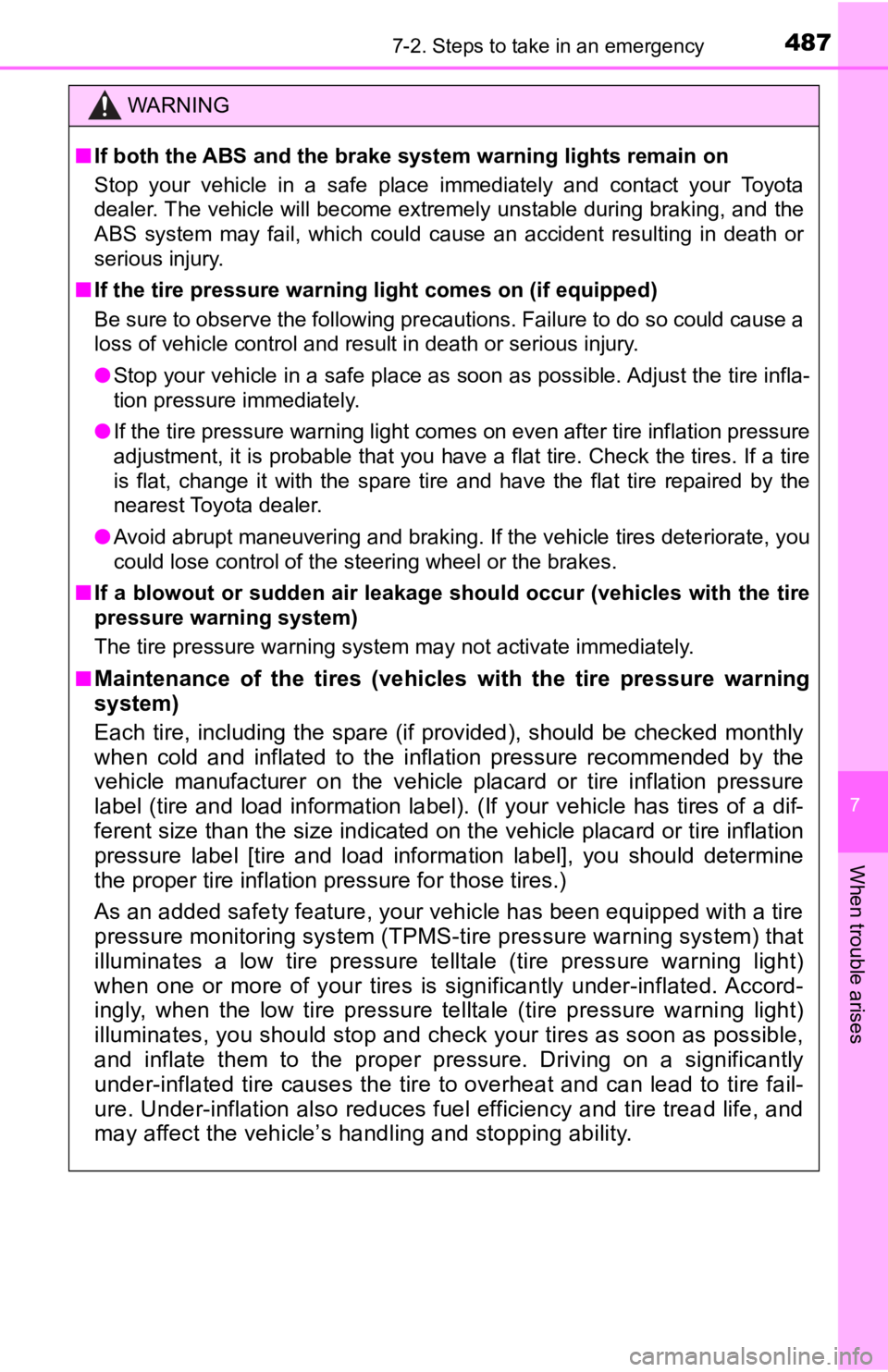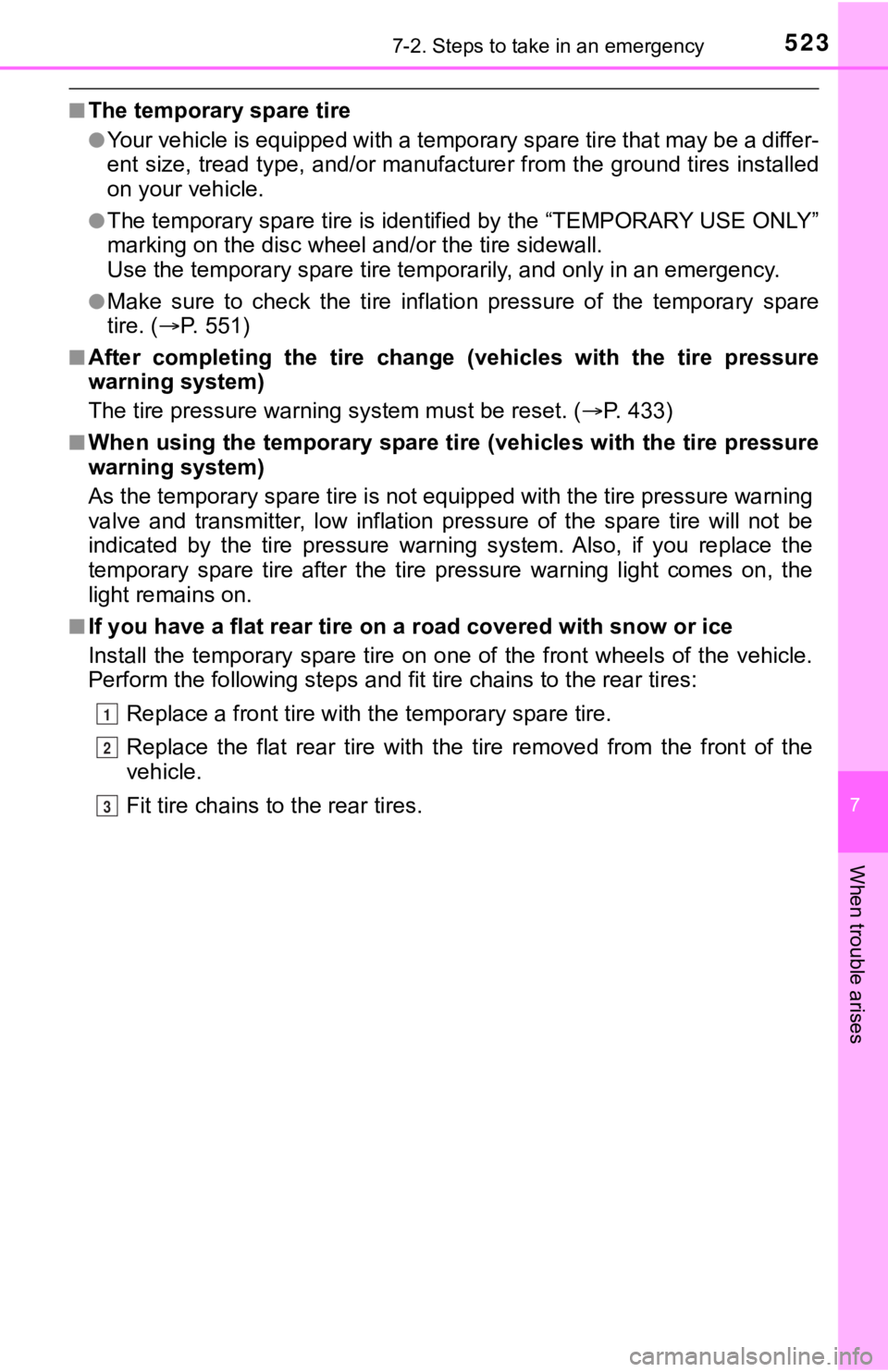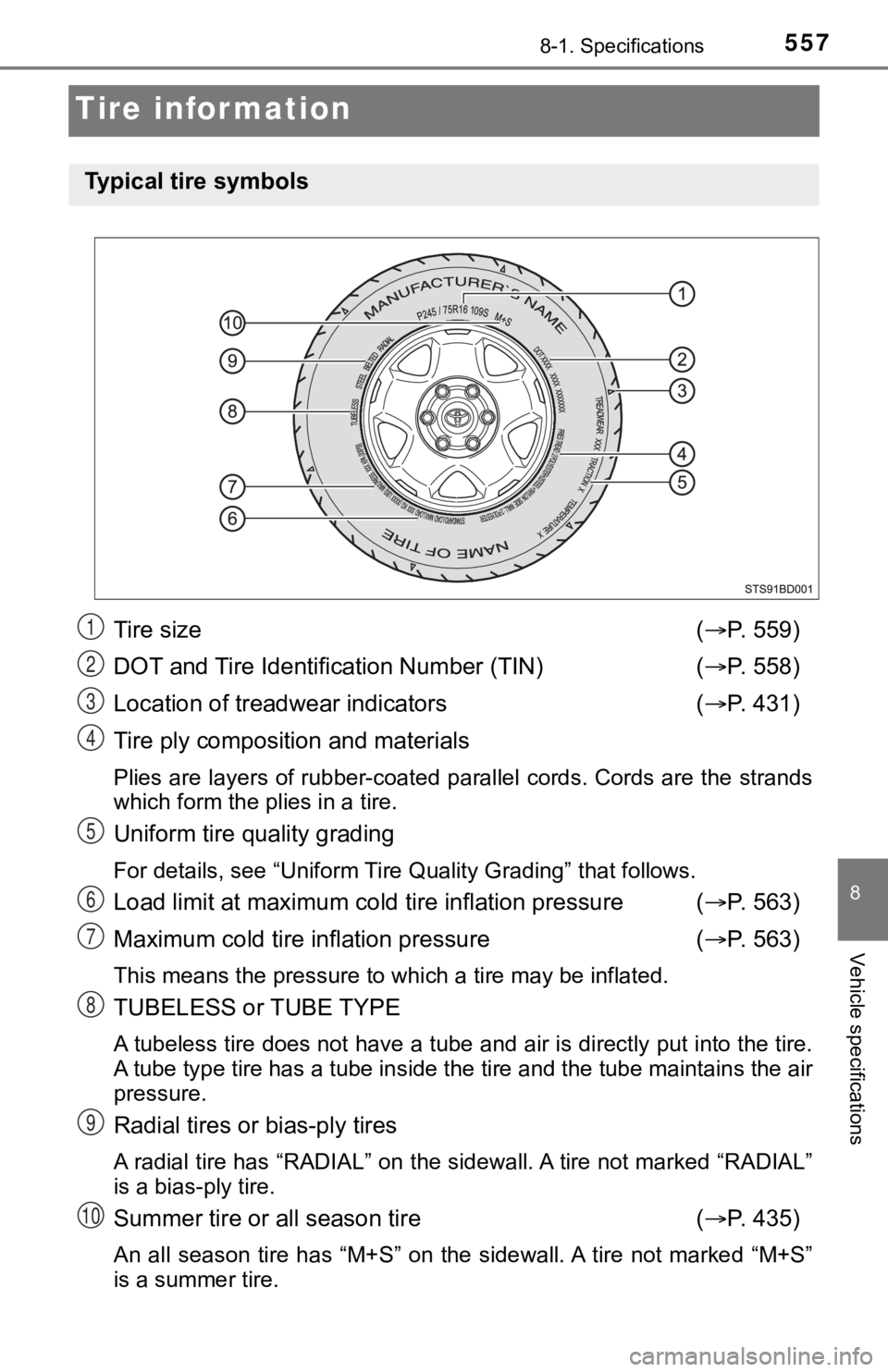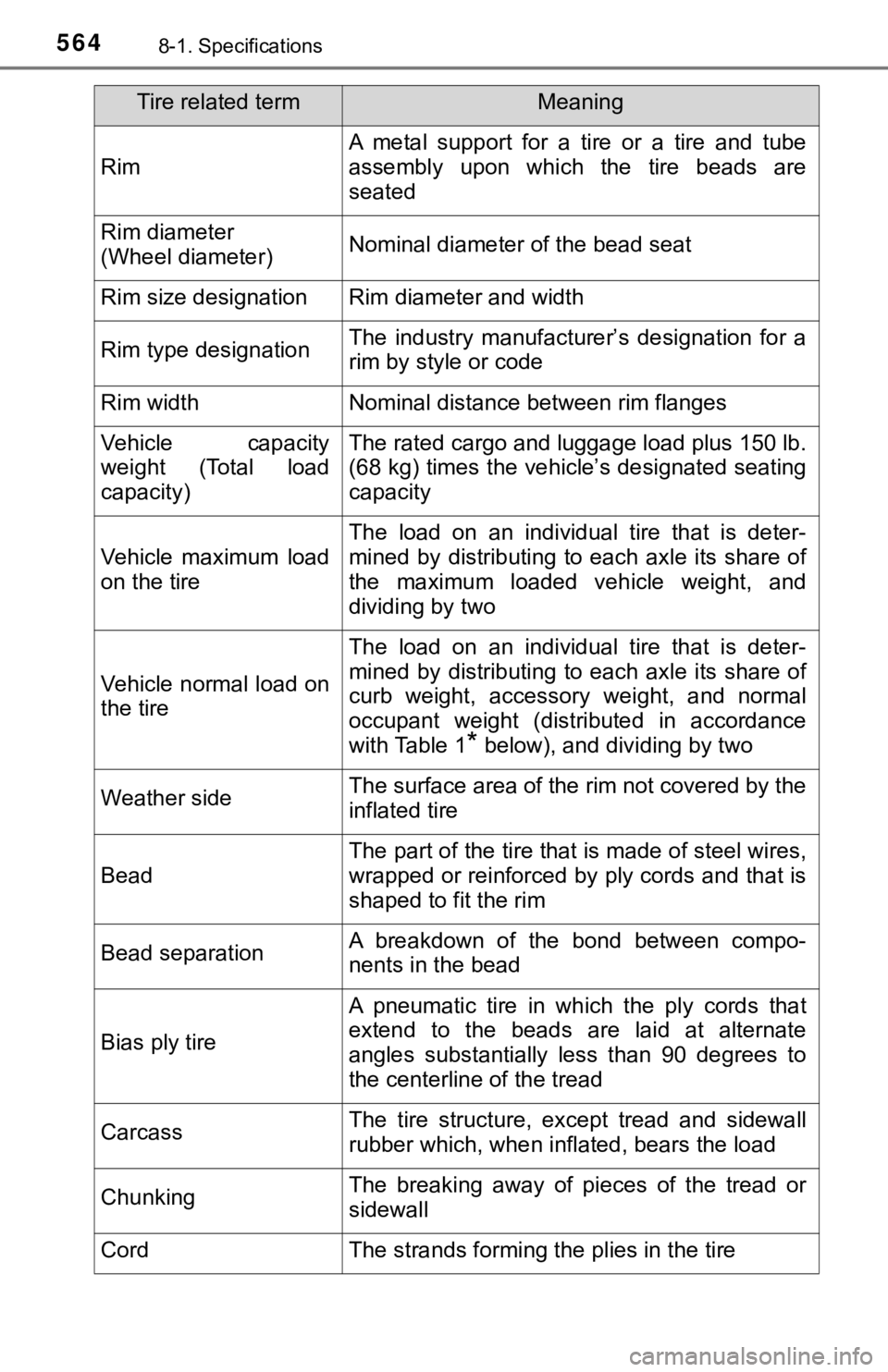Page 487 of 616

4877-2. Steps to take in an emergency
7
When trouble arises
WARNING
■If both the ABS and the brake system warning lights remain on
Stop your vehicle in a safe place immediately and contact your Toyota
dealer. The vehicle will become extremely unstable during braki ng, and the
ABS system may fail, which could cause an accident resulting in death or
serious injury.
■ If the tire pressure warning light comes on (if equipped)
Be sure to observe the following precautions. Failure to do so could cause a
loss of vehicle control and result in death or serious injury.
● Stop your vehicle in a safe place as soon as possible. Adjust the tire infla-
tion pressure immediately.
● If the tire pressure warning light comes on even after tire inf lation pressure
adjustment, it is probable that you have a flat tire. Check the tires. If a tire
is flat, change it with the spare tire and have the flat tire repaired by the
nearest Toyota dealer.
● Avoid abrupt maneuvering and braking. If the vehicle tires dete riorate, you
could lose control of the steering wheel or the brakes.
■ If a blowout or sudden air leakage should occur (vehicles with the tire
pressure warning system)
The tire pressure warning system may not activate immediately.
■
Maintenance of the tires (vehicles with the tire pressure warning
system)
Each tire, including the spare (if provided), should be checked monthly
when cold and inflated to the inflation pressure recommended by the
vehicle manufacturer on the vehicle placard or tire inflation p ressure
label (tire and load information label). (If your vehicle has t ires of a dif-
ferent size than the size indicated on the vehicle placard or t ire inflation
pressure label [tire and load information label], you should de termine
the proper tire inflation p ressure for those tires.)
As an added safety feature, your vehicle has been equipped with a tire
pressure monitoring system (TPMS-tire pressure warning system) that
illuminates a low tire pressure telltale (tire pressure warning light)
when one or more of your tires is significantly under-inflated. Accord-
ingly, when the low tire pressure telltale (tire pressure warni ng light)
illuminates, you should stop and check your tires as soon as po ssible,
and inflate them to the proper pressure. Driving on a significa ntly
under-inflated tire causes the tire to overheat and can lead to tire fail-
ure. Under-inflation also reduces fuel efficiency and tire tread life, and
may affect the vehicle’s handling and stopping ability.
Page 523 of 616

5237-2. Steps to take in an emergency
7
When trouble arises
■The temporary spare tire
●Your vehicle is equipped with a temporary spare tire that may be a differ-
ent size, tread type, and/or manufacturer from the ground tires installed
on your vehicle.
●The temporary spare tire is iden tified by the “TEMPORARY USE ON LY ”
marking on the disc wheel and/or the tire sidewall.
Use the temporary spare tire temp orarily, and only in an emergency.
●Make sure to check the tire inflation pressure of the temporary spare
tire. ( P. 5 5 1 )
■After completing the tire change (vehicles with the tire pressu re
warning system)
The tire pressure warni ng system must be reset. ( P. 433)
■When using the temporary spare tire (vehicles with the tire pre ssure
warning system)
As the temporary spare tire is no t equipped with the tire pressure warning
valve and transmitter, low inflation pressure of the spare tire will not be
indicated by the tire pressure warning system. Also, if you rep lace the
temporary spare tire after the tire pressure warning light come s on, the
light remains on.
■If you have a flat rear tire on a road covered with snow or ice
Install the temporary spare tire on one of the front wheels of the vehicle.
Perform the following steps and f it tire chains to the rear tires:
Replace a front tire with the temporary spare tire.
Replace the flat rear tire with the tire removed from the front of the
vehicle.
Fit tire chains to the rear tires.
1
2
3
Page 551 of 616
5518-1. Specifications
8
Vehicle specifications
Ty p e A
Ty p e B
Tires and wheels
Tire sizeP245/75R16 109S
Tire inflation pressure
(Recommended cold
tire inflation pressure)
Front tires:
32 psi (220 kPa, 2.2 kgf/cm2 or bar)
Rear tires:
32 psi (220 kPa, 2.2 kgf/cm
2 or bar)
Spare tire:
32 psi (220 kPa, 2.2 kgf/cm
2 or bar)
Wheel size16 × 7 J, 16 × 7 JJ (spare wheel)
Wheel nut torque83 ft·lbf (113 N·m, 11.5 kgf·m)
Tire size265/70R16 112T
Tire inflation pressure
(Recommended cold
tire inflation pressure)
Front tires:
30 psi (210 kPa, 2.1 kgf/cm2 or bar)
Rear tires:
30 psi (210 kPa, 2.1 kgf/cm
2 or bar)
Spare tire:
30 psi (210 kPa, 2.1 kgf/cm
2 or bar)
Wheel size16 × 7 J, 16 × 7 JJ (spare wheel)
Wheel nut torque83 ft·lbf (113 N·m, 11.5 kgf·m)
Page 552 of 616
5528-1. Specifications
Ty p e C
Tire sizeP265/65R17 110S, P265/60R18 109H,
P245/75R16 109S (spare tire)
Tire inflation pressure
(Recommended cold
tire inflation pressure)
Front tires:
29 psi (200 kPa, 2.0 kgf/cm2 or bar)
Rear tires:
29 psi (200 kPa, 2.0 kgf/cm
2 or bar)
Spare tire:
32 psi (220 kPa, 2.2 kgf/cm
2 or bar)
Wheel size17 7 1/2 J, 18 7 1/2 J,
16 7 JJ (spare wheel)
Wheel nut torque83 ft·lbf (113 N·m, 11.5 kgf·m)
Page 557 of 616

5578-1. Specifications
8
Vehicle specifications
Tire information
Tire size ( P. 559)
DOT and Tire Identification Number (TIN) ( P. 558)
Location of treadwear indicators ( P. 431)
Tire ply composition and materials
Plies are layers of rubber-coated parallel cords. Cords are the strands
which form the p lies in a tire.
Uniform tire quality grading
For details, see “Uniform Tire Q uality Grading” that follows.
Load limit at maximum cold tire inflation pressure ( P. 563)
Maximum cold tire inflation pressure ( P. 563)
This means the press ure to which a tire may be inflated.
TUBELESS or TUBE TYPE
A tubeless tire does not have a tube and air is directly put into the tire.
A tube type tire has a tube insi de the tire and the tube mainta ins the air
pressure.
Radial tires or bias-ply tires
A radial tire has “RADIAL” on the sidewall. A tire not marked “ RADIAL”
is a bias-ply tire.
Summer tire or all season tire ( P. 435)
An all season tire has “M+S” on the sidewall. A tire not marked “M+S”
is a summer tire.
Typical tire symbols
1
2
3
4
5
6
7
8
9
10
Page 558 of 616
5588-1. Specifications
DOT symbol*
Tire Identification Number (TIN)
Tire manufacturer’s identification mark
Tire size code
Manufacturer’s optional tire type code (3 or 4 letters)
Manufacturing week
Manufacturing year
Manufacturer’s code
*:The DOT symbol certifies that the tire conforms to applicable Federal
Motor Vehicle Safety Standards.
Typical DOT and Tire Iden tification Number (TIN)
Ty p e AType B
1
2
3
4
5
6
7
8
Page 559 of 616
5598-1. Specifications
8
Vehicle specifications
■Typical tire size information
The illustration indicates typical
tire size.
Tire use
(P = Passenger car,
T = Temporary use)
Section widt h (millimeters)
Aspect ratio
(tire height to section width)
Tire construction code ( R = Radial, D = Diagonal)
Wheel diameter (inches)
Load index (2 digits or 3 digits)
Speed symbol (alphabet with one letter)
■Tire dimensions
Section width
Tire height
Wheel diameter
Tire size
1
2
3
4
5
6
7
1
2
3
Page 564 of 616

5648-1. Specifications
Rim
A metal support for a tire or a tire and tube
assembly upon which the tire beads are
seated
Rim diameter
(Wheel diameter)Nominal diameter of the bead seat
Rim size designationRim diameter and width
Rim type designationThe industry manufacturer’s designation for a
rim by style or code
Rim widthNominal distance between rim flanges
Vehicle capacity
weight (Total load
capacity)The rated cargo and l uggage load plus 150 lb.
(68 kg) times the vehicle’s designated seating
capacity
Vehicle maximum load
on the tire
The load on an individual tire that is deter-
mined by distributing to each axle its share of
the maximum loaded vehicle weight, and
dividing by two
Vehicle normal load on
the tire
The load on an individual tire that is deter-
mined by distributing to each axle its share of
curb weight, accessory weight, and normal
occupant weight (distributed in accordance
with Table 1
* below), and dividing by two
Weather sideThe surface area of the rim not covered by the
inflated tire
Bead
The part of the tire that is made of steel wires,
wrapped or reinforced by ply cords and that is
shaped to fit the rim
Bead separationA breakdown of the bond between compo-
nents in the bead
Bias ply tire
A pneumatic tire in which the ply cords that
extend to the beads are laid at alternate
angles substantially less than 90 degrees to
the centerline of the tread
CarcassThe tire structure, except tread and sidewall
rubber which, when inflated, bears the load
ChunkingThe breaking away of pieces of the tread or
sidewall
CordThe strands forming th e plies in the tire
Tire related termMeaning